Computational Optimization of Sandwich Silicone Rubber Composite for Improved Thermal Conductivity and Electrical Insulation
Abstract
1. Introduction
2. Materials
3. FE Modeling
3.1. Multiscale FE Modeling
3.2. Material Properties of the Constituents
3.3. Boundary Conditions
3.3.1. Thermal Boundary Conditions
3.3.2. Electrical Boundary Conditions
4. Results and Discussion
4.1. Validation of FE Modeling Approach
4.2. Effects of Filler Volume Fractions
4.3. Effect of Filler Orientation
4.4. Effects of Layer Configuration
5. Conclusions
- The thermal conductivity of the SR/BN-SR/EG composite was significantly influenced by the filler orientation.
- The in-plane thermal conductivities of SR/BN and SR/EG exhibited a percolation phenomenon characterized by a sudden rise in thermal conductivity at a critical volume fraction of the fillers, attributable to the formation of a filler network.
- Percolation in SR/BN and SR/EG occurred at filler volume fractions of 35% and 30%, respectively.
- A larger filler required lower volume fractions to achieve percolation in the in-plane thermal conductivity.
- The electrical resistivity of the SR/BN-SR/EG composite increased exponentially with a decrease in the number of layers.
Funding
Institutional Review Board Statement
Data Availability Statement
Acknowledgments
Conflicts of Interest
References
- Garimella, S.V.; Fleischer, A.S.; Murthy, J.Y.; Keshavarzi, A.; Prasher, R.; Patel, C.; Bhavnani, S.H.; Venkatasubramanian, R.; Mahajan, R.; Joshi, Y.; et al. Thermal challenges in next-generation electronic systems. IEEE Trans. Compon. Packag. Technol. 2008, 31, 801–815. [Google Scholar] [CrossRef]
- Li, J.; Li, F.; Zhao, X.; Zhang, W.; Li, S.; Lu, Y.; Zhang, L. Jelly-inspired construction of the three-dimensional interconnected BN network for lightweight, thermally conductive, and electrically insulating rubber composites. ACS Appl. Electron. Mater. 2020, 2, 1661–1669. [Google Scholar] [CrossRef]
- Li, X.; Li, C.; Zhang, X.; Jiang, Y.; Xia, L.; Wang, J.; Song, X.; Wu, H.; Guo, S. Simultaneously enhanced thermal conductivity and mechanical properties of PP/BN composites via constructing reinforced segregated structure with a trace amount of BN wrapped PP fiber. Chem. Eng. J. 2020, 390, 124563. [Google Scholar] [CrossRef]
- Su, K.H.; Su, C.Y.; Cho, C.T.; Lin, C.H.; Jhou, G.F.; Chang, C.C. Development of thermally conductive polyurethane composite by low filler loading of spherical BN/PMMA composite powder. Sci. Rep. 2019, 9, 14397. [Google Scholar] [CrossRef] [PubMed]
- Fang, H.; Bai, S.-L.; Wong, C.P. “White graphene”-hexagonal boron nitride based polymeric composites and their application in thermal management. Compos. Commun. 2016, 2, 19–24. [Google Scholar] [CrossRef]
- Xu, X.; Zhou, J.; Chen, J. Thermal transport in conductive polymer–based materials. Adv. Funct. Mater. 2020, 30, 1904704. [Google Scholar] [CrossRef]
- Kinloch, I.A.; Suhr, J.; Lou, J.; Young, R.J.; Ajayan, P.M. Composites with carbon nanotubes and graphene: An outlook. Science 2018, 362, 547–553. [Google Scholar] [CrossRef]
- Du, B. Thermal conductivity and dielectric properties of silicone rubber nanocomposites. In Progress in Rubber Nanocomposites; Elsevier: Amsterdam, The Netherlands; pp. 495–522. Available online: https://www.sciencedirect.com/science/article/pii/B9780081004098000140 (accessed on 15 January 2024).
- Sisanth, K.S.; Thomas, M.G.; Abraham, J.; Thomas, S. General introduction to rubber compounding. In Progress in Rubber Nanocomposites; Elsevier: Amsterdam, The Netherlands; pp. 1–39. Available online: https://www.sciencedirect.com/science/article/pii/B9780081004098000012 (accessed on 15 January 2024).
- Gan, L.; Dong, M.; Han, Y.; Xiao, Y.; Yang, L.; Huang, J. Connection-improved conductive network of carbon nanotubes in a rubber cross-link network. ACS Appl. Mater. Interfaces 2018, 10, 18213–18219. [Google Scholar] [CrossRef]
- Xue, Y.; Li, X.; Wang, H.; Zhao, F.; Zhang, D.; Chen, Y. Improvement in thermal conductivity of through-plane aligned boron nitride/silicone rubber composites. Mater. Des. 2019, 165, 107580. [Google Scholar] [CrossRef]
- Li, D.; Dong, L.; Chen, Y.; Luo, C.; Zhou, J.; Liu, G.; Ren, H. Thermally conductive and antistatic properties of silicone rubber reinforced by the modified graphene oxide. Polymers 2022, 14, 4703. [Google Scholar] [CrossRef] [PubMed]
- Guo, Y.; Ruan, K.; Shi, X.; Yang, X.; Gu, J. Factors affecting thermal conductivities of the polymers and polymer composites: A review. Compos. Sci. Technol. 2020, 193, 108134. [Google Scholar] [CrossRef]
- Hu, Q.; Bai, X.; Zhang, C.; Zeng, X.; Huang, Z.; Li, J.; Li, J.; Zhang, Y. Oriented BN/silicone rubber composite thermal interface materials with high out-of-plane thermal conductivity and flexibility. Compos. A 2022, 152, 106681. [Google Scholar] [CrossRef]
- Zhang, Y.; Huang, J.; Cao, M.; Du, G.; Liu, Z.; Li, W. Preparation of boron nitride and silicone rubber composite material for application in lithium batteries. Energies 2021, 14, 999. [Google Scholar] [CrossRef]
- Namitha, L.K.; Ananthakumar, S.; Sebastian, M.T. Aluminum nitride filled flexible silicone rubber composites for microwave substrate applications. J. Mater. Sci. Mater. Electron. 2015, 26, 891–897. [Google Scholar] [CrossRef]
- Ou, Z.; Gao, F.; Zhu, L.; Zhao, H.; Xun, Z. Study on aluminum nitride/addition-cure liquid silicone rubber composite for high-voltage power encapsulation. PLoS ONE 2021, 16, e0252619. [Google Scholar] [CrossRef]
- Wang, X.; Nelson, J.K.; Schadler, L.S.; Hillborg, H. Mechanisms leading to nonlinear electrical response of a Nano p-SiC/silicone rubber composite. IEEE Trans. Dielectr. Electr. Insul. 2010, 17, 1687–1696. [Google Scholar] [CrossRef]
- Du, B.X.; Li, Z.L.; Yang, Z.R. Field-dependent conductivity and space charge behavior of silicone rubber/SiC composites. IEEE Trans. Dielectr. Electr. Insul. 2016, 23, 3108–3116. [Google Scholar] [CrossRef]
- Wu, J.; Song, X.; Gong, Y.; Yang, W.; Chen, L.; He, S.; Lin, J.; Bian, X. Analysis of the heat conduction mechanism for Al2O3/silicone rubber composite material with FEM based on experiment observations. Compos. Sci. Technol. 2021, 210, 108809. [Google Scholar] [CrossRef]
- Zhou, W.; Qi, S.; Tu, C.; Zhao, H.; Wang, C.; Kou, J. Effect of the particle size of Al2O3 on the properties of filled heat-conductive silicone rubber. J. Appl. Polym. Sci. 2007, 104, 1312–1318. [Google Scholar] [CrossRef]
- Gao, B.Z.; Xu, J.Z.; Peng, J.J.; Kang, F.Y.; Du, H.D.; Li, J.; Chiang, S.W.; Xu, C.J.; Hu, N.; Ning, X.S. Experimental and theoretical studies of effective thermal conductivity of composites made of silicone rubber and Al2O3 particles. Thermochim. Acta 2015, 614, 1–8. [Google Scholar] [CrossRef]
- Feng, C.-P.; Wan, S.-S.; Wu, W.-C.; Bai, L.; Bao, R.; Liu, Z.; Yang, M.; Chen, J.; Yang, W. Electrically insulating, layer structured SiR/GNPs/BN thermal management materials with enhanced thermal conductivity and breakdown voltage. Compos. Sci. Technol. 2018, 167, 456–462. [Google Scholar] [CrossRef]
- Tian, Z.; Sun, J.; Wang, S.; Zeng, X.; Zhou, S.; Bai, S.; Zhao, N.; Wong, C. A thermal interface material based on foam-templated three-dimensional hierarchical porous boron nitride. J. Mater. Chem. A 2018, 6, 17540–17547. [Google Scholar] [CrossRef]
- Jung, H.; Yu, S.; Bae, N.S.; Cho, S.M.; Kim, R.H.; Cho, S.H.; Hwang, I.; Jeong, B.; Ryu, J.S.; Hwang, J.; et al. High through-plane thermal conduction of graphene nanoflake filled polymer composites melt-processed in an L-shape kinked tube. ACS Appl. Mater. Interfaces 2015, 7, 15256–15262. [Google Scholar] [CrossRef] [PubMed]
- Gan, L.; Qiu, F.; Hao, Y.-B.; Zhang, K.; Zhou, Z.; Zeng, J.; Wang, M. Shear-induced orientation of functional graphene oxide sheets in isotactic polypropylene. J. Mater. Sci. 2016, 51, 5185–5195. [Google Scholar] [CrossRef]
- Cho, H.-B.; Nakayama, T.; Tokoi, Y.; Endo, S.; Tanaka, S.; Suzuki, T.; Jiang, W.; Suematsu, H.; Niihara, K. Facile preparation of a polysiloxane-based hybrid composite with highly-oriented boron nitride nanosheets and an unmodified surface. Compos. Sci. Technol. 2010, 70, 1681–1686. [Google Scholar] [CrossRef]
- Li, Q.; Guo, Y.; Li, W.; Qiu, S.; Zhu, C.; Wei, X.; Chen, M.; Liu, C.; Liao, S.; Gong, Y.; et al. Ultrahigh thermal conductivity of assembled aligned multilayer graphene/epoxy composite. Chem. Mater. 2014, 26, 4459–4465. [Google Scholar] [CrossRef]
- Hong, H.; Kim, J.U.; Kim, T.I. Effective assembly of nano-ceramic materials for high and anisotropic thermal conductivity in a polymer composite. Polymers 2017, 9, 413. [Google Scholar] [CrossRef] [PubMed]
- Hirahara, T. Designable core–shell graphite particles for thermally conductive and electrically insulating polymer composites. RSC Adv. 2018, 8, 16781–16787. [Google Scholar] [CrossRef]
- Xue, Y.; Li, X.; Wang, H.; Zhang, D.; Chen, Y. Thermal conductivity improvement in electrically insulating silicone rubber composites by the construction of hybrid three-dimensional filler networks with boron nitride and carbon nanotubes. J. Appl. Polym. Sci. 2019, 136, 46929. [Google Scholar] [CrossRef]
- Zhang, P.; Zeng, J.; Zhai, S.; Xian, Y.; Yang, D.; Li, Q. Thermal properties of graphene filled polymer composite thermal interface materials. Macromol. Mater. Eng. 2017, 302, 1700068. [Google Scholar] [CrossRef]
- Xiong, R.; Hu, K.; Grant, A.M.; Ma, R.; Xu, W.; Lu, C.; Zhang, X.; Tsukruk, V.V. Ultrarobust transparent cellulose nanocrystal-graphene membranes with high electrical conductivity. Adv. Mater. 2016, 28, 1501–1509. [Google Scholar] [CrossRef] [PubMed]
- Song, N.; Jiao, D.; Cui, S.; Hou, X.; Ding, P.; Shi, L. Highly anisotropic thermal conductivity of layer-by-layer assembled nanofibrillated cellulose/graphene nanosheets hybrid films for thermal management. ACS Appl. Mater. Interfaces 2017, 9, 2924–2932. [Google Scholar] [CrossRef] [PubMed]
- Zhang, X.; Zhang, J.; Li, C.; Wang, J.; Xia, L.; Xu, F.; Zhang, X.; Wu, H.; Guo, S. Endowing the high efficiency thermally conductive and electrically insulating composites with excellent antistatic property through selectively multilayered distribution of diverse functional fillers. Chem. Eng. J. 2017, 328, 609–618. [Google Scholar] [CrossRef]
- Xue, Y.; Wang, H.; Li, X.; Chen, Y. Exceptionally thermally conductive and electrical insulating multilaminar aligned silicone rubber flexible composites with highly oriented and dispersed filler network by mechanical shearing. Compos. A 2021, 144, 106336. [Google Scholar] [CrossRef]
- Sun, Y.; Zhou, L.; Han, Y.; Cui, L.; Chen, L. A new anisotropic thermal conductivity equation for h-BN/polymer composites using finite element analysis. Int. J. Heat. Mass. Transf. 2020, 160, 120157. [Google Scholar] [CrossRef]
- Ding, D.; Zhang, S.; Liang, H.; Wang, X.; Wu, Y.; Ye, Y.; Liu, Z.; Zhang, Q.; Qin, G.; Chen, Y. Enhancing thermal conductivity of silicone rubber composites by in-situ constructing SiC networks: A finite-element study based on first principles calculation. Nano Res. 2023, 16, 1430–1440. [Google Scholar] [CrossRef]
- Khosravani, S.; Sadr, M.H.; Carrera, E.; Pagani, A.; Masia, R. Multi-scale analysis of thermal conductivity of graphene foam/PDMS composites. Mech. Adv. Mater. Struct. 2023, 1–13. [Google Scholar] [CrossRef]
- Matos, M.A.; Tagarielli, V.L.; Pinho, S.T. On the electrical conductivity of composites with a polymeric matrix and a non-uniform concentration of carbon nanotubes. Compos. Sci. Technol. 2020, 188, 108003. [Google Scholar] [CrossRef]
- Wang, S.; Huang, Y.; Chang, E.; Zhao, C.; Ameli, A.; Naguib, H.E.; Park, C.B. Evaluation and modeling of electrical conductivity in conductive polymer nanocomposite foams with multiwalled carbon nanotube networks. Chem. Eng. J. 2021, 411, 128382. [Google Scholar] [CrossRef]
- Li, C.; Tan, L.Y.; Zeng, X.L.; Zhu, D.L.; Sun, R.; Xu, J.B.; Wong, C.P. Polymer composites with high thermal conductivity optimized by polyline-folded graphite paper. Compos. Sci. Technol. 2020, 188, 107970. [Google Scholar] [CrossRef]
- Dassault Systèmes. Abaqus, version 6.14; Dassault Systèmes: Vélizy-Villacoublay, France, 2015. [Google Scholar]
- Chen, L.; Sun, Y.-Y.; Lin, J.; Du, X.; Wei, G.; He, S.; Nazarenko, S. Modeling and analysis of synergistic effect in thermal conductivity enhancement of polymer composites with hybrid filler. Int. J. Heat Mass. Transf. 2015, 81, 457–464. [Google Scholar] [CrossRef]
- Chen, L.; Sun, Y.-Y.; Xu, H.-F.; He, S.; Wei, G.; Du, X.; Lin, J. Analytic modeling for the anisotropic thermal conductivity of polymer composites containing aligned hexagonal boron nitride. Compos. Sci. Technol. 2016, 122, 42–49. [Google Scholar] [CrossRef]
- Kim, K.K.; Kim, S.M.; Lee, Y.H. A new horizon for hexagonal boron nitride film. J. Korean Phys. Soc. 2014, 64, 1605–1616. [Google Scholar] [CrossRef]
- Zhou, W.; Qi, S.; Zhao, H.; Liu, N. Thermally conductive silicone rubber reinforced with boron nitride particle. Polym. Compos. 2007, 28, 23–28. [Google Scholar] [CrossRef]
- Norley, J.; Tzeng, J.-W.; Getz, G.; Klug, J.; Fedor, B. The development of a natural graphite heat-spreader. In Proceedings of the Seventeenth Annual IEEE Semiconductor Thermal Measurement and Management Symposium; Cat. No. 01CH37189. Institute of Electrical and Electronics Engineers (IEEE): Piscataway, NJ, USA; pp. 107–110. [CrossRef]
- Murugan, P.; Nagarajan, R.D.; Shetty, B.H.; Govindasamy, M.; Sundramoorthy, A.K. Recent trends in the applications of thermally expanded graphite for energy storage and sensors—A review. Nanoscale Adv. 2021, 3, 6294–6309. [Google Scholar] [CrossRef] [PubMed]
- Jiji, L.M.; Danesh-Yazdi, A.H. Heat Conduction, 4th ed.; Springer Nature: Cham, Switzerland, 2024. [Google Scholar]
- Alghamdi, A.A.; Alharthi, H.A. Multiscale finite-element modelling of the electrical conductivity of polyvinylchloride–nickel composites. J. Compos. Mater. 2019, 53, 1255–1260. [Google Scholar] [CrossRef]
- Zheng, X.; Zhan, Y.; Shi, J.; Lu, M.; Wu, K. Improved thermal conductivity and excellent electrical insulation properties of polysiloxane nanocomposite-incorporated functional boron nitride sheets via in situ polymerization. Nanoscale 2023, 15, 13025–13036. [Google Scholar] [CrossRef] [PubMed]
- Niu, H.; Ren, Y.; Guo, H.; Małycha, K.; Orzechowski, K.; Bai, S. Recent progress on thermally conductive and electrical insulating rubber composites: Design, processing and applications. Compos. Commun. 2020, 22, 100430. [Google Scholar] [CrossRef]
- Oluwalowo, A.; Nguyen, N.; Zhang, S.; Park, J.G.; Liang, R. Electrical and thermal conductivity improvement of carbon nanotube and silver composites. Carbon 2019, 146, 224–231. [Google Scholar] [CrossRef]
- Su, Y.; Li, J.J.; Weng, G.J. Theory of thermal conductivity of graphene-polymer nanocomposites with interfacial Kapitza resistance and graphene-graphene contact resistance. Carbon 2018, 137, 222–233. [Google Scholar] [CrossRef]
- Aradhana, R.; Mohanty, S.; Nayak, S.K. Novel electrically conductive epoxy/reduced graphite oxide/silica hollow microspheres adhesives with enhanced lap shear strength and thermal conductivity. Compos. Sci. Technol. 2019, 169, 86–94. [Google Scholar] [CrossRef]
- Alghamdi, A.A. Computational assessment of effect of porosity on thermal conductivity of 3D-printed PEEK/carbon-fiber composite. J. Compos. Mater. 2023, 57, 3807–3820. [Google Scholar] [CrossRef]


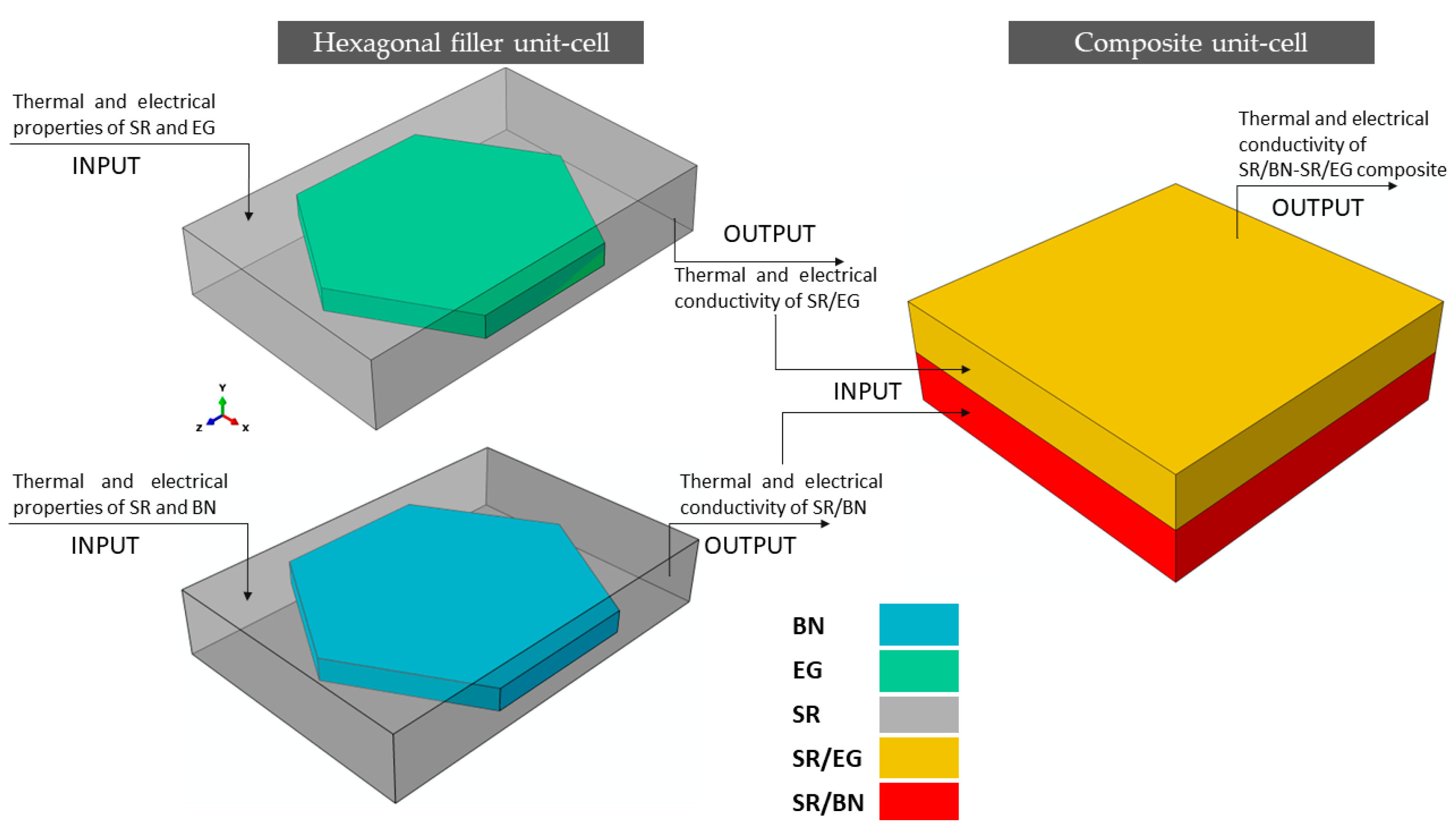
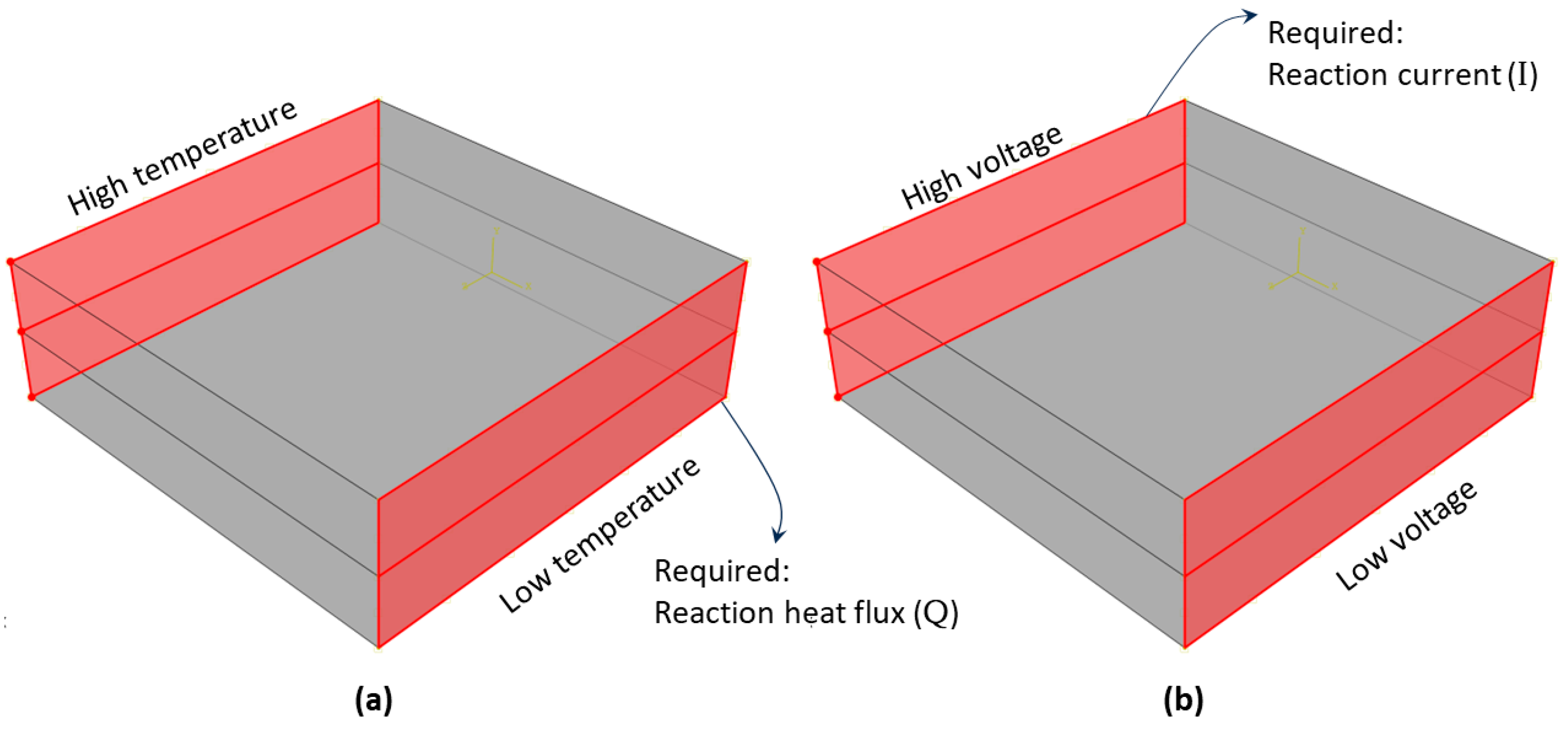


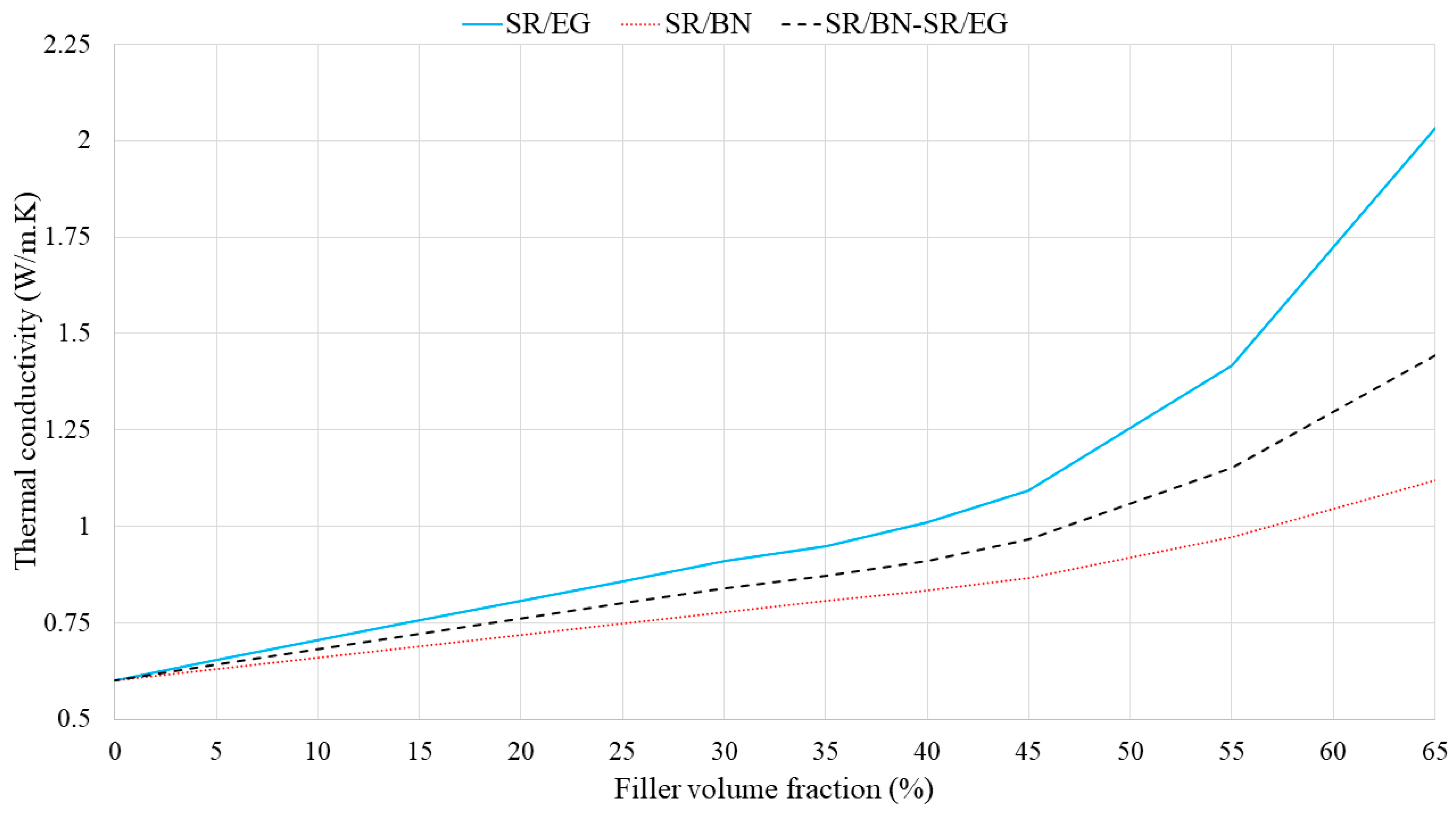
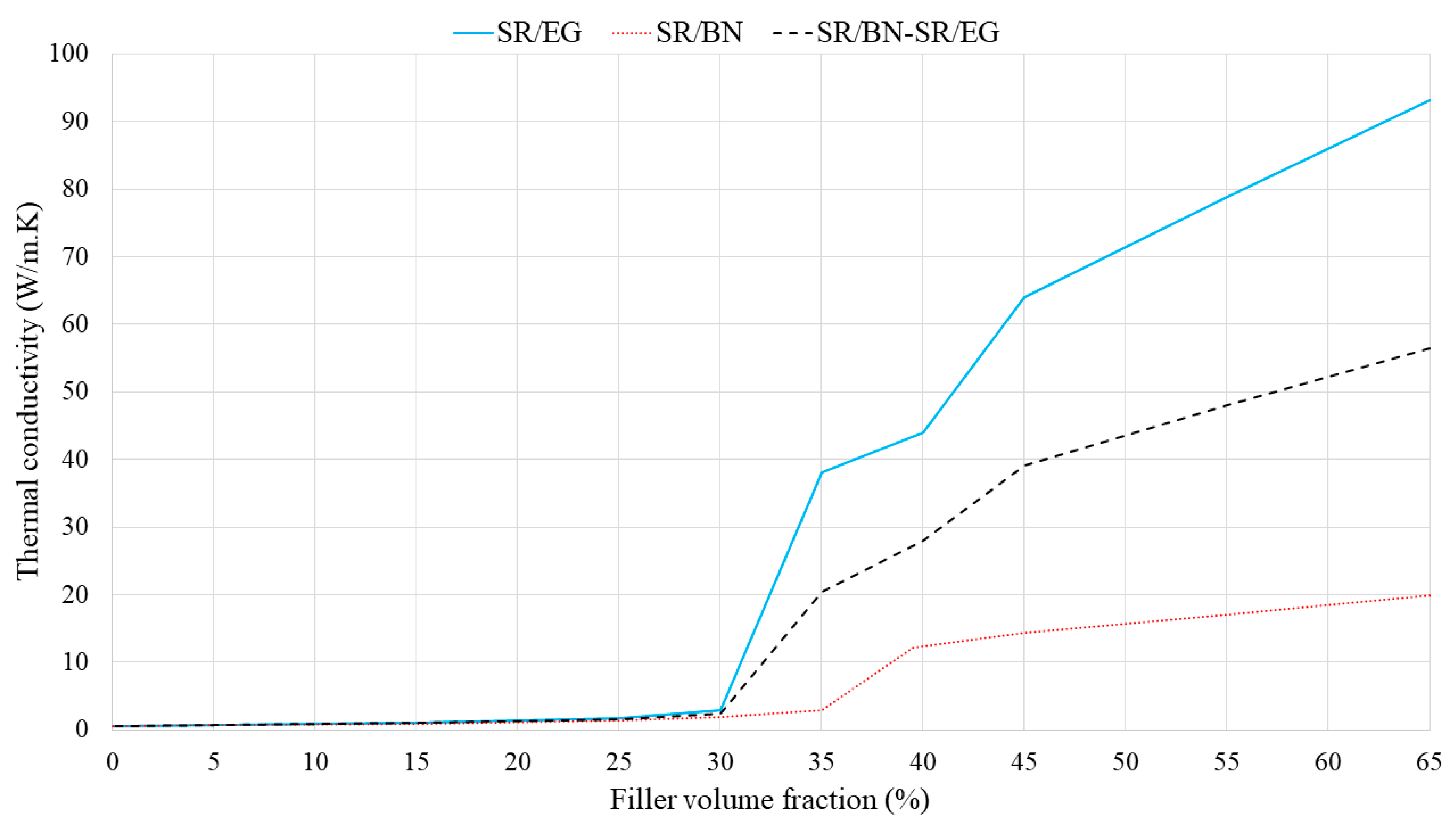






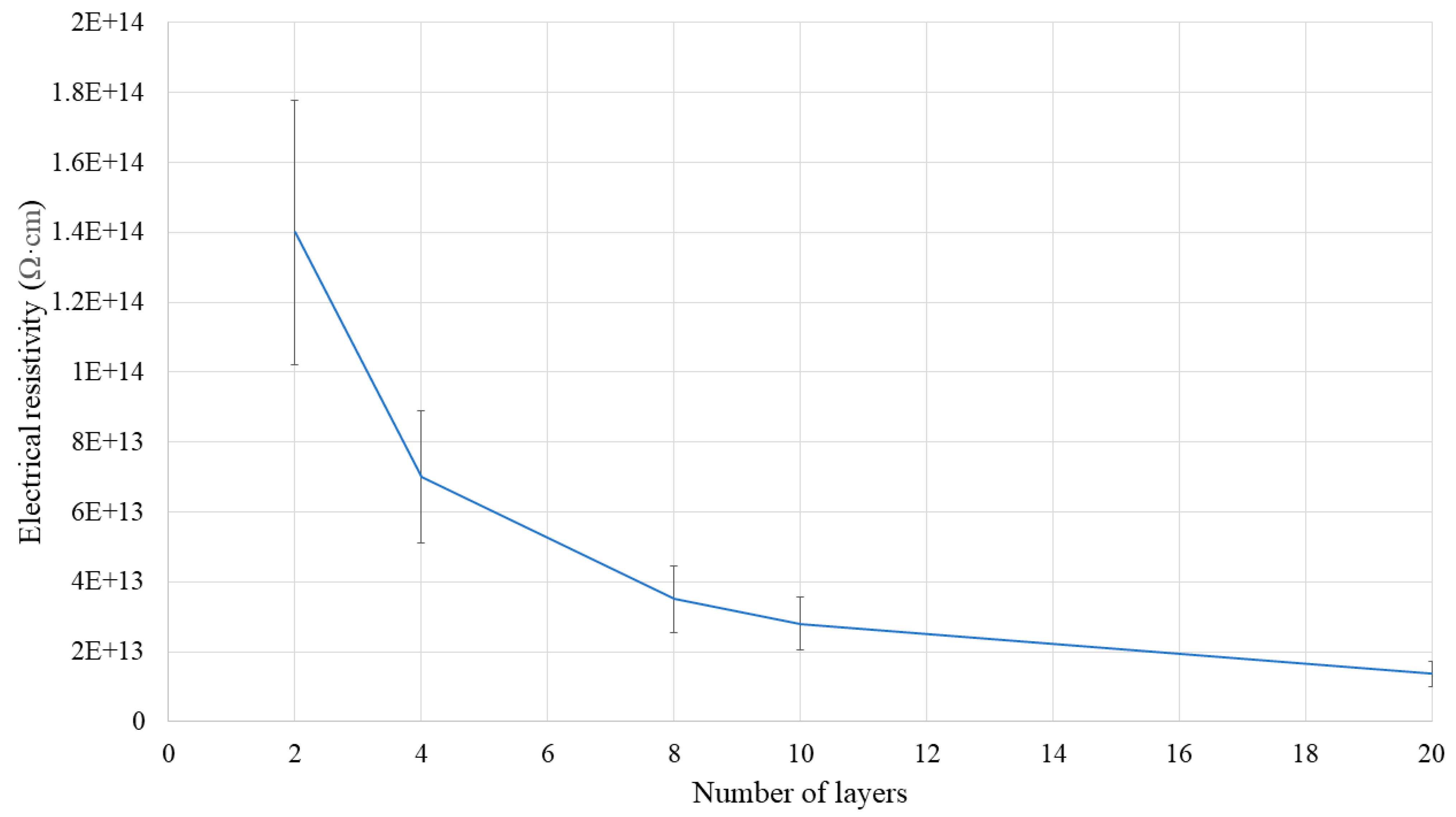
| Layer | Dimensions (µm) | |||||
|---|---|---|---|---|---|---|
| L | W | H | a | b | d | |
| SR/BN | 8.66 | 12 | 0.475 | 8.66 | 0.3 | 10 |
| SR/EG | 17.32 | 24 | 0.178 | 17.32 | 0.1 | 20 |
| Phase | Thermal Conductivity | Electrical Resistivity | Source | |
|---|---|---|---|---|
| W⋅m−1⋅K−1 | Ω·cm | |||
| Boron nitride | 62 (||) | 1.5 (⊥) | ≥1013 | [46,47] |
| Expanded graphite | 233 (||) | 4.5 (⊥) | ≤10−5 | [48,49] |
| Silicone rubber | 0.6 | ≥1016 | [36,47] | |
| Layer | Thermal Conductivity (W⋅m−1⋅K−1) | |||
|---|---|---|---|---|
| Through-Thickness | In-Plane (x) | In-Plane (z) | In-Plane (Average) | |
| SR/BN | 0.83 | 22.56 | 1.86 | 12.21 |
| SR/EG | 0.95 | 74.11 | 1.93 | 38.02 |
| Direction | Thermal Conductivity (W⋅m−1⋅K−1) | Difference withExperimental Results (%) | |
|---|---|---|---|
| Experimental | Finite Element Model | ||
| Through-thickness | 0.7 ± 0.01 | 0.88 | 25.71% |
| In-plane | 23.4 ± 0.3 | 25.11 | 7.31% |
| Layer | Electrical Resistivity (Ω·cm) | |
|---|---|---|
| Discontinuous Filler | Continuous Filler | |
| SR/BN | 3.10 × 1016 | 2.80 × 1014 |
| SR/EG | 1.53 × 1016 | 3.16 × 10−4 |
| Electrical Resistivity (Ω·cm) | ||
|---|---|---|
| Discontinuous Filler | Continuous Filler | |
| Composite | 2.31 × 1016 | 1.40 × 1014 |
Disclaimer/Publisher’s Note: The statements, opinions and data contained in all publications are solely those of the individual author(s) and contributor(s) and not of MDPI and/or the editor(s). MDPI and/or the editor(s) disclaim responsibility for any injury to people or property resulting from any ideas, methods, instructions or products referred to in the content. |
© 2024 by the author. Licensee MDPI, Basel, Switzerland. This article is an open access article distributed under the terms and conditions of the Creative Commons Attribution (CC BY) license (https://creativecommons.org/licenses/by/4.0/).
Share and Cite
Alghamdi, A.A. Computational Optimization of Sandwich Silicone Rubber Composite for Improved Thermal Conductivity and Electrical Insulation. Polymers 2024, 16, 616. https://doi.org/10.3390/polym16050616
Alghamdi AA. Computational Optimization of Sandwich Silicone Rubber Composite for Improved Thermal Conductivity and Electrical Insulation. Polymers. 2024; 16(5):616. https://doi.org/10.3390/polym16050616
Chicago/Turabian StyleAlghamdi, Abdulrahman A. 2024. "Computational Optimization of Sandwich Silicone Rubber Composite for Improved Thermal Conductivity and Electrical Insulation" Polymers 16, no. 5: 616. https://doi.org/10.3390/polym16050616
APA StyleAlghamdi, A. A. (2024). Computational Optimization of Sandwich Silicone Rubber Composite for Improved Thermal Conductivity and Electrical Insulation. Polymers, 16(5), 616. https://doi.org/10.3390/polym16050616







